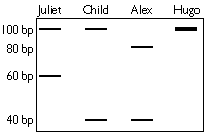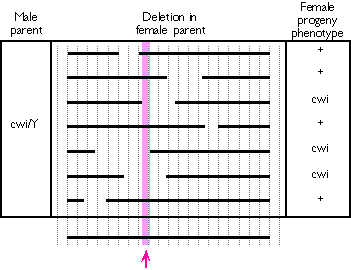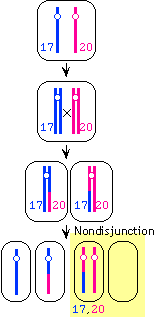You use PCR to genotype Juliet, her child, Alex, and Hugo at the polymorphic locus PS6 . The PS6 locus is shown below as a gray box, along with 10 base pairs of flanking sequence on each side of the PS6 locus. Which set of primers shown below would you use to amplify the PS6 locus? Circle one primer set. (5 pts)
![]()
|
Primer set 1:
|
Primer set 2: <---- this is the correct set
|
|
Primer set 3:
|
Primer set 4:
|
 You use gel electrophoresis to separate the DNA products obtained
from each of the PCR reactions. The gel is depicted on the right.
You use gel electrophoresis to separate the DNA products obtained
from each of the PCR reactions. The gel is depicted on the right.
PS6 is a microsatellite repeat locus with repeat units of two (2) base pairs in length. Using this information, determine the genotype (number of repeats in each allele) of each person at PS6. (12 pts)
Juliet: __20, 40____ Alex ___10, 30___
Child __10, 40____ Hugo ___40, 40___
Of Alex and Hugo, who cannot be the child's father? Explain in ONE sentence. (8 pts)
Hugo -- the identity of the mother is not in question, and it's clear that the child received the 100 bp allele from the mom (Juliet). So the dad must have the 40 bp allele, and Hugo does not have that allele.
 (14 pts total) H.J. Muller's experiment to estimate the mutation frequency in
Drosophila yielded a variety of strains of flies that carry recessive
lethal mutations. In addition, his crosses yielded some strains
that carry mutations that do NOT cause lethality when recessive
but do cause other phenotypes. You are interested in the process
of wing formation, so you identify a strain of Muller's that carries
a non-lethal X-chromosome mutation that causes crumpled wings.
The crosses shown depict Muller's cross that generated the crumpled
wings (cwi ) mutation. [NOTE: w+ and w are the same white gene
alleles that you heard about in lecture.]
(14 pts total) H.J. Muller's experiment to estimate the mutation frequency in
Drosophila yielded a variety of strains of flies that carry recessive
lethal mutations. In addition, his crosses yielded some strains
that carry mutations that do NOT cause lethality when recessive
but do cause other phenotypes. You are interested in the process
of wing formation, so you identify a strain of Muller's that carries
a non-lethal X-chromosome mutation that causes crumpled wings.
The crosses shown depict Muller's cross that generated the crumpled
wings (cwi ) mutation. [NOTE: w+ and w are the same white gene
alleles that you heard about in lecture.]

 Nondisjunction in meiosis I in the mom could give this genotype
{17,20,6} if there had been an even number of crossovers (or no
crossovers) between PS1 and the centromere; but ND-II could also
give this genotype if there had been an odd number of crossovers
between the centromere and PS1, such that the chromatids that
failed to disjoin had different alleles on them.
Nondisjunction in meiosis I in the mom could give this genotype
{17,20,6} if there had been an even number of crossovers (or no
crossovers) between PS1 and the centromere; but ND-II could also
give this genotype if there had been an odd number of crossovers
between the centromere and PS1, such that the chromatids that
failed to disjoin had different alleles on them.